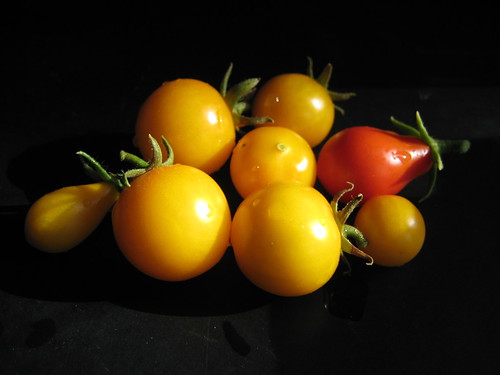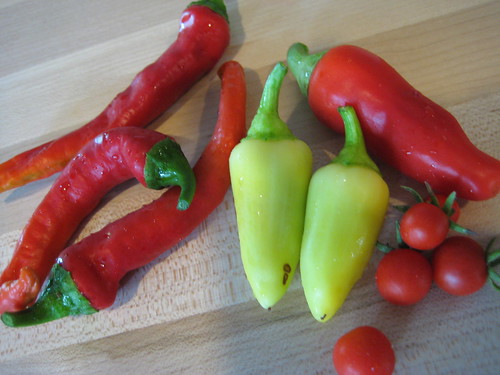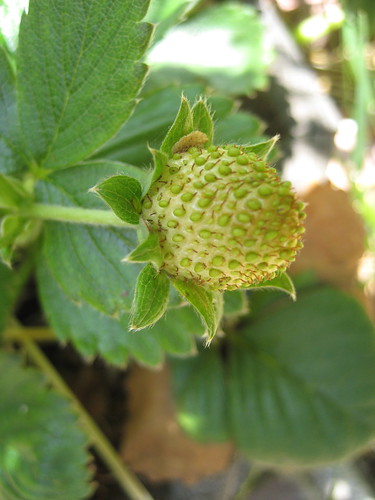In an attempt to ensure tomato success this season, I planted only small fruiting varieties. Happily, all three types I chose produced attractive, tasty fruit. The most prolific and hardy were the Mexico Midget and Hartman's Yellow Gooseberry heirloom varieties, which I purchased from Seed Savers. I particularly recommend the Hartman's Gooseberry. They're a lovely, gold color and have a tart, fresh taste that even I, a professed tomato-hater, kind of enjoy.
The Austin Red Pear tomatoes were the most temperamental variety. They were annoyingly prone to blossom end rot, despite diligent mulching and plenty of crushed eggshells in the soil. This surprised me, because I've grown other pear tomatoes in the past with great success. The plant that did best was the one planted in the front yard. The Austin Pears in containers lost about half their fruit to the evil rot.

Notice that one yellow pear on the far left? For some reason, one of my red pear tomato plants ended up making yellow pears. I don't know if it was a plant mutation or if some of the wrong seed made it into my packet, but I don't mind.
Peppers were another successful summer crop. As usual, they began producing fruit much later than the tomatoes, but now that they're fruiting, things are going fairly well. The earliest harvest came from the Wenk's Yellow Hot. It's a thick-skinned, fat pepper that starts light yellow-green and then turns red. Next came my Maule's Red Hots, which look and taste similar to cayenne peppers. Both those varieties have been producing fairly steadily since late July.

Unfortunately, despite the presence several leafy, healthy plants in my garden, I am still waiting on to try the Fish Peppers. I hope the plants bloom soon, because the fruit looks so pretty in the seed catalog pictures. I'm having similar issues with my Listada de Gandia eggplants. There are least five good-looking plants in containers and the ground, but not a single one has made an eggplant. I think I'm running out of time with those, because eggplants need hot weather to flower.
Earlier in the summer, I had some modest success with my green beans. I have a few plants left, but I think they're probably done producing for the year. I'll cut them off at the soil surface soon and leave their nice nitrogen-fixing roots in the ground to decompose.
My corn, sadly, has been a complete failure. This is my second year trying corn, and I think it may be my last. Corn takes up a lot of space and needs significant amounts of water. So, I think I give up on corn farming. It hardly seems worth it considering how cheap and plentiful corn is in summer farmers markets.
I have already documented my frustrating relationship with squash. So far, I've harvested only two yellow zucchini squash despite carefully tending to 10 plants. Sigh. I don't think I'm ready to give up on all squash just yet, but I will probably plant fewer hills next year to make room for some more reliable vegetables. And I am going to quit winter squash for a while. All sectors of my Los Angeles garden seem unable to produce a single winter variety. (I know it's possible, since Ilsa at Rambling LA grows gorgeous pumpkins in her yard.)

To end my summer garden assessment on a brighter note, my first foray into strawberry growing has been fun and tasty. My two plants continue to spread in their pots and produce new fruit. I hope to keep them alive through the winter so I can have more delicious, homegrown strawberries from these plants next year.
Very soon, it'll be time to begin my winter garden. I've started a few seeds in pots, and will start working the soil this weekend to get it ready for planting. Hopefully, the weather will cool down by mid-October so my seedlings don't get scorched.


Post a Comment